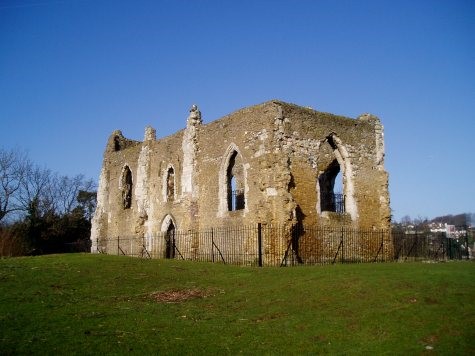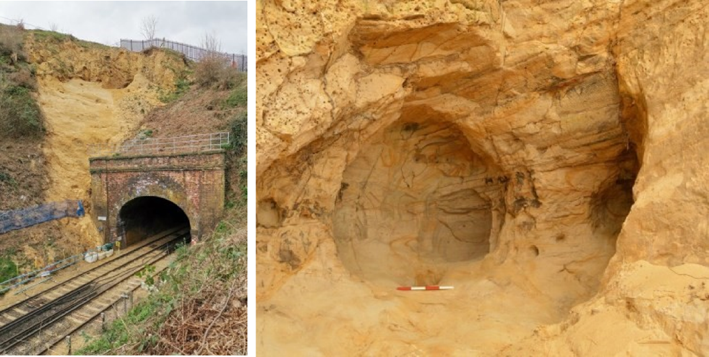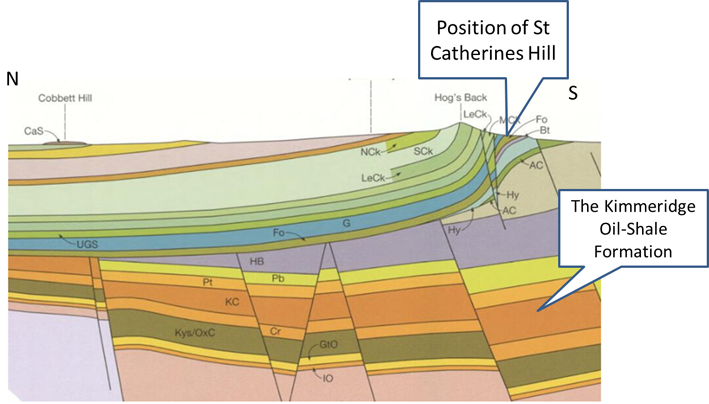by Graham Dean
Have medieval oil wells been discovered in Guildford?
Excavations dating from medieval times have been discovered by workmen from Network Rail on the historic St Catherine’s Hill on the southern edge of Guildford.
The workings were revealed during remedial work after a landslip in December closed the Guildford to Portsmouth rail line. The regrading had started on the sandy slopes above the railway tunnel that was bored through the hill in the mid-19th century.

St Catherine’s Chapel, on top of the hill, was built in the late 13th century in the reign of Edward I.
Over the years evidence has been discovered of more distant human activity on the hill in the Iron Age, Bronze Age and even Mesolithic (middle Stone Age) periods.
Images taken from the medieval workings show a Gothic niche decorated in dots with a Calvary cross nearby.

A spokesperson from Archaeology South East, said: "The cave contained what appear to be shrines or decorative niches, together with carved initials and other markings. The old name for St Catherine's Hill is Drakehull 'The Hill of the Dragon', so this has obviously been a site of ritual significance long before the construction of the church on the top of the hill in the late 13th century.”
The sandstone workings are made up of several sections ranging from 0.3 metres to about 0.7 metres high. The small width of the workings has given rise to speculation that the workings may be medieval “horizontal oil wells” dug into the side of the hill in an attempt to pool and collect the oil that seeps to the surface at St Catherines.
Today the oil comes to the surface only occasionally as an oil sheen on a spring in one of the private gardens at the bottom of the hill but in earlier times the flow of oil may have been much greater. The oil source is likely to be the underlying Jurassic Kimmeridge and if so might hint that the shale is geochemically more mature than previously assumed.

A geological N-S cross section showing the position of St Catherines south of the North Downs Hogs Back Hill. The oil has been squeezed out of the underlying Kimmeridge Oil-Shale Formation and rises to the surface over geological time.
The Dragon Hill name could derive from the presence of oil and gas. Gas seeping from the ground sometimes ignites and burns continuously. If this happened on St Catherine’s Hill it would be easy to imagine a fire-breathing dragon lurking beneath.
The oil seep is probably why the hill is named after St Catherine. In the middle ages the monks of St Catherine’s monastery in Sinai in Egypt collected and sold oil from an oil seep. They marketed the oil as the tears of St Catherine. The oil was hugely popular as it was claimed to heal leprosy and many other complaints. Oil does not cure leprosy but it did help clear up skin rashes that were very common during medieval times. One of the reported miracles of Edward the Confessor was that he rubbed some of the oil on a man’s face to cure him.
In medieval times demand for St Catherine’s oil was so large that oil seeps across Europe were rebranded in the name of St Catherine. One example is St Catherine’s Well in Liberton in Edinburgh. The Edinburgh oil well had a chapel similar to the Guildford chapel until Oliver Cromwell banned oil production. The Saint Catherine cult was especially popular in Normandy and in Norman times many English churches had a shrine to St Catherine but the cult seemed to wane in England in the years just before the reformation.
This article originally featured in the PESGB magazine.
KeyFacts Energy Industry Directory: PESGB
 KEYFACT Energy
KEYFACT Energy